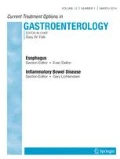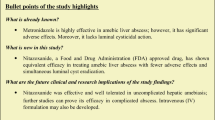Opinion statement
-
More than 80% of cases of amebic liver abscess can be managed with a 14-day course of intravenous or oral metronidazole. In cases of suspected amebic liver abscess, treatment should be started before diagnostic confirmation.
-
If no clinical improvement is evident by 72 to 96 hours, treatment should be changed to dehydroemetine and chloroquine.
-
Invasive treatment is necessary only in patients in whom medical treatment fails within 5 days or in whom signs of clinically severe disease are present.
-
A 10-day course with a luminal agent such as paromomycin to eliminate intestinal cysts, which are resistant to imidazoles, should always follow treatment of the liver abscess.
-
Percutaneous catheter drainage is indicated in patients with impending rupture, with a lesion 6 cm or more in diameter, with an abscess located in the left lobe or high in the dome of the right lobe, or in whom medical treatment fails.
-
Although sympathetic pleural effusion is not an indication for drainage, direct pulmonary involvement or spread to pleural or lung tissues requires drainage.
-
Intraperitoneal rupture and peritonitis necessitate open surgical drainage.
-
Only a small minority of amebic liver abscesses are secondarily infected by other organisms.
-
Because relapses are possible, feces should be checked for cysts monthly for several months after therapy.
Similar content being viewed by others
References and Recommended Reading
Shandera WX, Bollam P, Hashmey RH, et al.: Hepatic amebiasis among patients in a public teaching hospital. South Med J 1998, 91:829–837.
Brooke MM: Epidemiology of amebiasis in the US. JAMA 1964, 188:519–521.
Holtan N: Amebiasis: the ancient scourge is still with us. Postgrad Med 1988, 83:65–72.
Akgun Y, Tacyildiz IH, Celik Y: Amebic liver abscess: changing trends over 20 years. World J Surg 1999, 23:102–106.
Thompson JE, Forlenza S, Verma R: Amebic liver abscess: a therapeutic approach. Rev Infect Dis 1985, 7:171–179.
Ravdin J: Amebiasis. Clin Infect Dis 1995, 20:1453–1466.
Li E, Stanley SL Jr: Protozoa: amebiasis. Gastroenterol Clin North Am 1996, 25:471–492. This very complete review of amebiasis includes good sections on pathogenesis and cytopathology as well as diagnosis and treatment.
Sharma MP, Dasarathy S, Verma N, et al.: Prognostic markers in amebic liver abscess: a prospective study. Am J Gastroenterol 1996, 91:2584–2588.
Rajak CL, Gupta S, Jain S, et al.: Percutaneous treatment of liver abscesses: needle aspiration versus catheter drainage. AJR Am J Roentgenol 1998, 170:1035–1039. This is a well-conducted study comparing needle aspiration and catheter drainage for the treatment of amebic liver abscess.
Singh JP, Kashyap A: A comparative evaluation of percutaneous catheter drainage for resistant amebic liver abscesses. Am J Surg 1989, 158:58–62.
Craft JC: Amebiasis. In Infectious Diseases, edn 5. Edited by Hoeprich J, Jordan M, Ronald A. Philadelphia: JB Lippincott; 1994:763–768.
Reed SL: Entamoeba histolytica and other intestinal amoebae. Infectious Diseases, edn 2. Edited by Wgorbach L, Bartlett J, Blaclow N. Philadelphia: WB Saunders; 1998. Up-to-date chapter provides concise summary of current concepts related to amebiasis.
Zhang T, Cieslak PR, Stanley SL Jr: Protection of gerbils from amebic liver abscess by immunization with a recombinant Entamoeba histolytica antigen. Infect Immun 1994, 62:1166–1170.
Ralls PW, Barnes PF, Johnson MB, et al.: Medical treatment of hepatic amebic abscess: rare need for percutaneous drainage. Radiology 1987, 165:805–807.
Frey CF, Zhu Y, Suzuki M, et al.: Liver abscesses. Surg Clin North Am 1989, 69:259–271.
Meng XY, Wu JX: Perforated amebic liver abscess: clinical analysis of 110 cases. South Med J 1994, 87:985–990.
Filice C, Di Perri G, Strosselli M, et al.: Outcome of hepatic amebic abscesses managed with three different therapeutic strategies. Dig Dis Sci 1992, 37:240–247.
Author information
Authors and Affiliations
Rights and permissions
About this article
Cite this article
Badalamenti, S., Jameson, J.E. & Reddy, K.R. Amebiasis. Curr Treat Options Gastro 2, 97–103 (1999). https://doi.org/10.1007/s11938-999-0036-z
Issue Date:
DOI: https://doi.org/10.1007/s11938-999-0036-z




